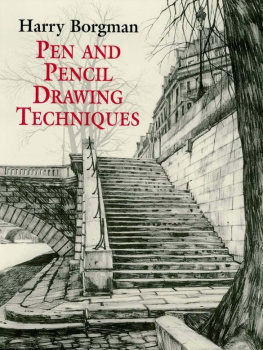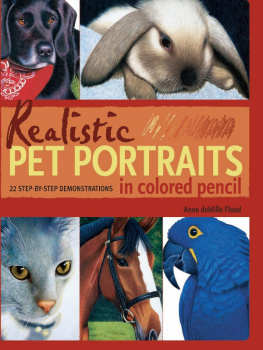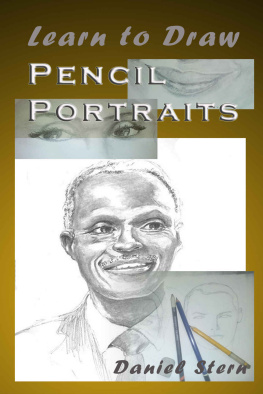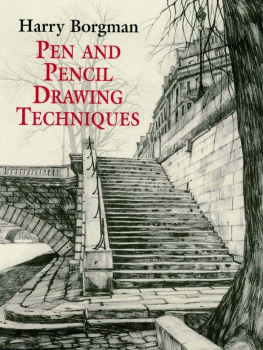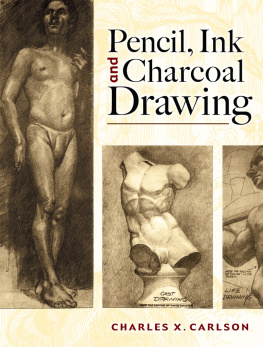Harry Borgman - Pen and Pencil Drawing Techniques (Dover Art Instruction)
Here you can read online Harry Borgman - Pen and Pencil Drawing Techniques (Dover Art Instruction) full text of the book (entire story) in english for free. Download pdf and epub, get meaning, cover and reviews about this ebook. genre: Home and family. Description of the work, (preface) as well as reviews are available. Best literature library LitArk.com created for fans of good reading and offers a wide selection of genres:
Romance novel
Science fiction
Adventure
Detective
Science
History
Home and family
Prose
Art
Politics
Computer
Non-fiction
Religion
Business
Children
Humor
Choose a favorite category and find really read worthwhile books. Enjoy immersion in the world of imagination, feel the emotions of the characters or learn something new for yourself, make an fascinating discovery.
- Book:Pen and Pencil Drawing Techniques (Dover Art Instruction)
- Author:
- Genre:
- Rating:3 / 5
- Favourites:Add to favourites
- Your mark:
- 60
- 1
- 2
- 3
- 4
- 5
Pen and Pencil Drawing Techniques (Dover Art Instruction): summary, description and annotation
We offer to read an annotation, description, summary or preface (depends on what the author of the book "Pen and Pencil Drawing Techniques (Dover Art Instruction)" wrote himself). If you haven't found the necessary information about the book — write in the comments, we will try to find it.
Harry Borgman: author's other books
Who wrote Pen and Pencil Drawing Techniques (Dover Art Instruction)? Find out the surname, the name of the author of the book and a list of all author's works by series.
Pen and Pencil Drawing Techniques (Dover Art Instruction) — read online for free the complete book (whole text) full work
Below is the text of the book, divided by pages. System saving the place of the last page read, allows you to conveniently read the book "Pen and Pencil Drawing Techniques (Dover Art Instruction)" online for free, without having to search again every time where you left off. Put a bookmark, and you can go to the page where you finished reading at any time.
Font size:
Interval:
Bookmark:
FIRST, BE SURE to study all the technique examples and step-by-step demonstrations. Go over these examples carefully until you understand how they were done. The step-by-step demonstrations are especially important because you can study the drawings at their various stages. At first, the diverse number of technique examples may seem confusing, but as you study them, you will begin to understand how they were done. Even the differences in styles will become more apparent as you develop your drawing skills.
When you begin working with the techniques, dont work on several at a time. Stick to one technique until you feel you have mastered it. Then go to another one. Also, practice all the exercises as I have suggested, for they will provide background for later techniques. They will also familiarize you with the various drawing tools and paper surfaces.
When you attempt any of the techniques, be sure to begin with simple subject matter. And keep your drawings small until your skills are developed. This way you wont become discouraged, and you will progress rapidly. After you feel at ease with simpler techniques, progress to more complicated ones.
I cannot stress enough the importance of practicing often. If you were learning to play the piano, you would practice a great deal. The same holds true for drawing or painting. Also, it is advisable for you to enroll in a basic drawing or life drawing class. Many schools offer such classes in the evenings or on Saturdays. Working with a competent art instructor will be very helpful. Meeting other art students is also important, for it will give you the opportunity to see others work and to discuss art with people who share your interest. Try to expose yourself to as much art as possible. Go to galleries and museums, where you can study drawings and paintings. Such trips can be quite stimulating and inspiring.
There are also many books and magazines on art, which can be found in your local library. You might even want to purchase a few good books for handy reference material. Everything you see and read about art will help you develop as an artist.
Remember what I said about disciplineit is an extremely important part of being an artist. You must be self-motivated.
Drawingespecially learning how to drawmay seem at first appearances to be quite a chore. But if you look at it as a wonderful learning process, a very new world may open up for you. If you are determined and work hard, you may be pleased to see much progress in a relatively short period of time. For this reason, it is a good idea to keep all your drawings and sketches so that you can compare your earlier work with later endeavors. You will have an actual record of how far youve progressed over a period of time.
Drawing is a pleasure, which you will discover as you progress and develop an ease of accomplishment. At the beginning, it can be tough, but when some of the mystery is taken out of drawing through your own experience and developing expertise, drawing will increasingly seem a pleasure and a challenge you look forward to.
IF YOU ARE SERIOUS about drawing, you will need to know about the many possibilities available in this medium. One way to gain more skill in your drawing, so that you can move from the simple to the complex, is to learn about your drawing tools and how to handle them. This chapter will tell you what the best materials are and how to use them. Just knowing your tools can give you a measure of confidence, which will reflect itself in your work.
Fortunately for artists and art students, there are a great variety of drawing pencils available, as well as many excellent paper surfaces to work on.
Graphite Pencils . The traditional basic drawing toolthe graphite pencilis made of compressed graphite that is encased in cedarwood. It is available in many different grades, ranging from very hard to very soft. The order of grading is 9H, 8H, 7H, 6H, 5H, 4H, 3H, 2H, H, HB, B, 2B, 3B, 4B, 5B, and 6B. The 9H lead is the hardest grade, and the 6B is the softest. Personally I prefer using the HB grade for general work and often use the H and 2H grades as well. Experiment with a few of the different grades to see which you prefer. Generally speaking, the harder grades work better on smooth, hard-surface paper, and the softer grades work better on textured paper.
With regard to lead grades, the harder the lead, the lighter the line; the softer the lead, the darker the line. The harder gradesthose above 2H are usually used for drafting or for mechanical drawing; the softer grades are used for general drawing. For sketching, the very soft grades2B through 6Bare best; the hard 2H to B grades are better for meticulous renderings.
Many fine brands of graphite pencils are available, and you will have to try a few of them to see which you prefer. Some brands I have found to be excellent are Berol Eagle turquoise, Koh-I-Noor, Mars Lumograph, and Venus. Some graphite pencils especially suited for sketching have very broad, flat leads for drawing thick lines. These sketching pencils usually come in grades of 2B, 4B, and 6B. The Ebony pencil, which has a large diameter and a very black lead, is also quite good.
Charcoal and Carbon Pencils . There are many types of charcoal and carbon pencils on the market. A good brand is General Charcoal. It is a deep black and comes in grades of HB, 2B, 4B, 6B, and in white. Wolff carbon pencils are also quite good, and they come in grades of HH, H, HB, B, BB, and BBB, which is the softest.
Wax-Type Pencils . One of my favorite drawing pencils is the Koh-I-Noor Hardtmuth Negro pencil. It has a wax-type lead that is jet black, and it is available in five degrees of hardness. Many other wax-type pencils are on the market; some have very fine leads, whereas others have very soft, thick leads.
A . Graphite
B . Charcoal and carbon
C . Carb-Othello pastel
D . Berol Eagle turquoise Prismacolor
E . Cont white
F . Koh-I-Noor Hardtmuth Negro
G . Stabilo
H . Faber Castel Polychromos
I . Caran DAche Prismalo water-soluble
J . China marking pencils and litho crayons
K . Hardtmuth Cyklop
A . Pencil pointed with a sharpener
B . Sharpened with an X-Acto knife and a sanding block
C . Chisel-pointed with a sandpaper block
D . Two ways to sharpen charcoal pencils
E . Blunt point for beavier lines.
F . Graphite sticks with different drawing edges
G . Mechanical pencil for thin, even lines
I have used Berol Prismacolor pencils for many years and have found them to be uniform in color and lead consistency. Their leads are smooth, thick, and strong enough to sharpen to a fine point. Their color range is wide, comprising sixty colors. Prismacolor pencils can be purchased singly or in sets of 12, 24, 36, 48, or 60 colors. These pencils can also be used in conjunction with other mediums, such as markers, dyes, watercolors, and other painting mediums. They can be blended or smudged with a paper stump dampened with Bestine, a rubber-cement solvent.
China Marking Pencils . These pencils are available in several colors, including white, black, brown, red, blue, green, yellow, and orange. Stabilo, another wax-type pencil, is also available in eight colors.
Water-Soluble Pencils. Another interesting pencil is the Caran DAche water-soluble pencil. You can wash clear water over the drawn lines with a brush and dissolve the tones to create a pencil painting. You can also use Caran DAche pencils without dissolving the tones. This brand offers forty brilliant colors, whose strong leads can be sharpened to a fine point. Other types of water-soluble pencils are also available.
Pastels. These come in pencil form and are a very interesting medium to work with. They can be blended easily with your fingers or a paper stump and are especially suitable for soft effects. The brand I use is Carb-Othello, which is available in sixty colors, with matching pastel chalks that can be used for covering large areas. These pencils sharpen well for detailed work and have a large-diameter lead that can be used to draw broad strokes.
Font size:
Interval:
Bookmark:
Similar books «Pen and Pencil Drawing Techniques (Dover Art Instruction)»
Look at similar books to Pen and Pencil Drawing Techniques (Dover Art Instruction). We have selected literature similar in name and meaning in the hope of providing readers with more options to find new, interesting, not yet read works.
Discussion, reviews of the book Pen and Pencil Drawing Techniques (Dover Art Instruction) and just readers' own opinions. Leave your comments, write what you think about the work, its meaning or the main characters. Specify what exactly you liked and what you didn't like, and why you think so.

